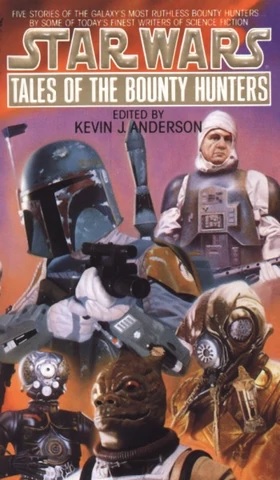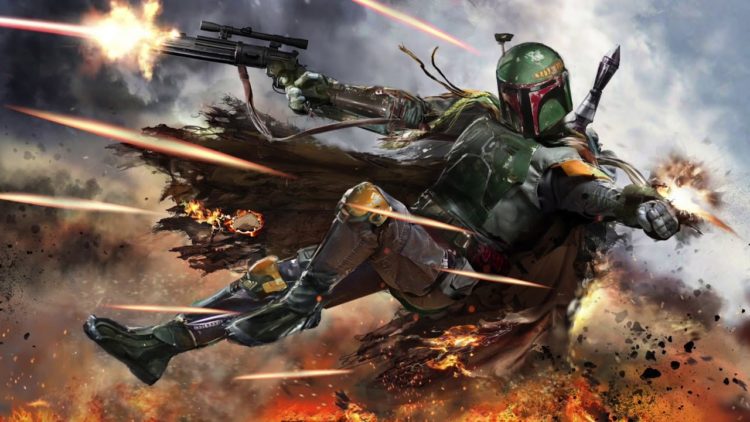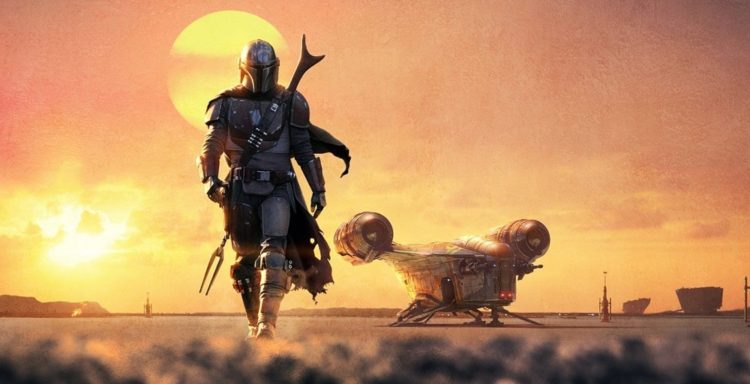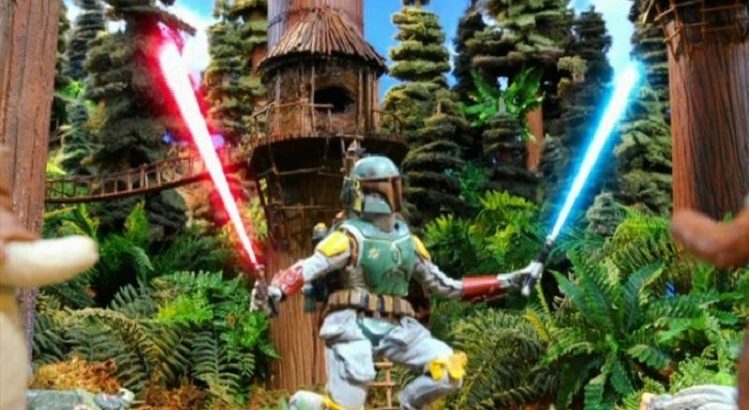How many of our readers out there remember the show Robot Chicken? It was a sketch comedy show with crude stop motion puppetry, and odds are if you do remember it you mainly remember their various Star Wars segments or specials. I ask because there’s a particular sketch that’s been stuck in my mind ever since it originally aired over a decade ago. It’s a cold open for an episode that has Boba Fett returning from the dead to arrive on Endor’s moon, killing a bunch of Ewoks with blasters, rockets and lightsabers, and winding up with Leia clad in her gold bikini wrapped in his arms. The segment then switches perspective to show that the whole scenario was a fantasy narrated by the show’s stereotypical nerd character, a fantasy his equally nerdy friends fawn over.
It’s meant to be satire and is a pretty biting one at that. And the most biting part about it is that it’s not too far off from a lot of the stories that did involve or star the OG Mandalorian. Boba Fett has been both a role-fulfillment and wish-fulfillment fantasy character for authors and fans of Star Wars since his first appearance, and perhaps more than any other character in the whole saga in terms of what he does in “official” material versus his role onscreen. As time has gone on his character has evolved and developed away from that, but those fantasies haven’t gone away, and the old version of Fett (or a character like him) is still sought after.
Let’s get a couple of definitions really quickly: wish-fulfillment means that a character does things that the author or the author’s intended audience wish they could do in real life but can’t. Role-fulfillment means a character that people want to see within a given fictional universe and haven’t, so they adjust an existing character to fit that bill. And I want to emphasize that neither of these are inherently negative things. They are, like all creative tropes, tools in a creator’s toolbox, and it’s how they’re used that ultimately matters. In the context of this discussion, many people have used Boba Fett both to fill a role that appeals to them that Star Wars otherwise lacks, and to do things in Star Wars that they might like to do. I can illustrate both of these points with an example.
For the better part of a decade the definitive Boba Fett story was “The Last Man Standing” by Daniel Keys Moran. The cornerstone of the Tales of the Bounty Hunters short story collection, the story was a Tarantino-esque non-chronological retelling of Fett’s life and career, getting deeper into both his head and his backstory than most stories did until much later. It was compelling stuff, especially with its cliffhanger ending leaving Fett and Han Solo in a standoff with blasters drawn, hence the story’s title. It also features one of the most awkward scenes in the whole Expanded Universe from a tone and intention standpoint. One of the scenes relayed for us is a hitherto unseen part of the story at Jabba’s Palace during Return of the Jedi; Fett is given the opportunity to assault or otherwise abuse Princess Leia when she (complete with gold bikini) is tossed into his sleeping quarters the night before the execution at Carkoon is to take place. And Fett’s response is to do nothing.

“Cover yourself, I’m not going to touch you.”
Organa moved slightly to the side, leaned over and grabbed the sheet and wrapped it around herself and the brief costume Jabba had allowed her, and backed up again into the corner of the room that left her farthest away from Fett. “You’re not?”
Fett shook his head. […] “Sex between those not married,” said Fett, “is immoral.”
“Yeah,” said Organa. “So’s rape.”
Fett nodded. “So is rape.”
Leaving aside the of-its-era prose, tone and words that would never be put into a Star Wars book today, and the frankly vile portrayal of Leia as an entirely helpless woman at Fett’s mercy, I want to talk about what this scene represents. This scene and the scene in the Robot Chicken episode have a major thing in common: they are both a fulfillment fantasy for a male, heterosexual creator on behalf of a male, heterosexual audience. The difference is that one is being played for laughs and the other is played entirely straight, and no prizes for guessing which is which. How many (likely male) fans put themselves in Fett’s place in the “Last Man Standing” scene, nobly refusing to take advantage of the helpless Princess Leia? How many used this scene to anchor the idea of Boba Fett as a noble demon in their head, a character who could be admired or even emulated?
Boba Fett could have had Princess Leia to himself for a night, but chose not to out of a sense of morality because, while he may be a killer for hire, he is not one to abide sex out of wedlock. All of which is a frankly ridiculous line for the character to draw for any reason, except that it is deliberately used by Daniel Keys Moran to give the audience something positive about Boba Fett to latch onto. Fett could assault Leia, but he doesn’t, he in fact has an oddly traditional, almost Judeo-Christian view of the sanctity of marriage, and that means that somewhere, deep down, he’s a good person. This is just one example of what Fett’s characterization was like at the time, but it’s one of the widest spread and certainly most beloved. Given that, he can slide into the same sort of character archetype as other early-nineties pop culture icons like the Punisher, Rorschach and Wolverine. All of them are violent men who are ruthless and won’t hesitate to kill for their own reasons outside of established law and order, but each has enough of a moral streak to not be a straight-up villain.
From his initial appearance up to the early 2000s, Boba Fett was that character for Star Wars. Despite his few minutes of screentime in the two films and even fewer lines, he was a featured player in novels, short stories, RPG campaigns, video games and comics, and only occasionally was he portrayed as an outright villain (and many of those appearances were later retconned to be other characters impersonating him anyway). In most of his appearances in this era Fett is an antihero, and sometimes even the outright hero of a given story, including an entire book trilogy written around him. He also appeared in numerous fanworks, especially in fan films, and again is typically a violent antihero rather than a villain, pitted against Imperials or other underworld elements who are all worse than he is.

Let’s be clear for a moment: Boba Fett’s core concept is an intriguing one even apart from that nineties portrayal. A man in a mask who doesn’t show his real face, covered in battered armor and equipped with many, many tools to commit violence, is a Star Wars spin on the “Man With No Name” trope from Westerns, something directly stated by Joe Johnston and other creatives during the production of The Empire Strikes Back. The difference is that the Man With No Name gets much more screentime devoted to his actions so the audience gets an idea of what sort of man he is behind the mystery. In contrast, Fett has few lines, accomplishes little aside from trailing the Falcon and capturing Han, and no real discernible personality beyond being indignant at Vader. All of that helps his appeal more than hurts it, because the most important part of him for many people is being able to make him whatever they want. The fact that he’s only portrayed as a villain in the movies’ context does nothing whatsoever to lessen that appeal, since we’re still given a blank slate with an air of mystery and danger and a cool visual design.
Is it any wonder that Fett’s popularity began to wane and a lot of fan backlash arose after Attack of the Clones was released and we got the entire backstory of Boba Fett rewritten in one sweep? No longer could he be a blank-slate wish- or role-fulfillment character, not in the same way, because here was Boba Fett as a precocious boy, a clone of a rather more plot-important (and charismatic) man named Jango. He wasn’t cool, he wasn’t quiet, he wasn’t really a badass killer like he had been before. The character now had a backstory, a family, and a motivation. Shortly after that, just to ram the point home, Jango’s actor re-recorded Boba’s lines in the original films, emphatically underlining for all but the most stubborn fans that this was the new reality, that this was Boba Fett. Pretty soon after, the merchandise, books and other media shifted their focus to Jango and his legacy, and eventually, a wholly reinvented Mandalorian culture via Karen Traviss’s work.

But love for the “classic” Boba Fett has never gone away, and now we have a series called The Mandalorian on the horizon. Said titular protagonist is said to be a mostly-silent armor-wearing gadget-hefting stone-cold badass bounty hunter, which all sounds very much like that old nineties version of Fett, taken far enough to the next level that he doesn’t even have a name. And while not much footage of the show itself has been shown, it seems to be very much like a lot of those old fan films, pitting underworld against underworld, full of corrupt Imperials and immoral gangsters that will allow the Mandalorian to be the hero even though in a traditional Star Wars story he would very likely be a villain. All of the fans who grew up thinking that Boba Fett was incredibly awesome and cool and that Attack of the Clones ruined him now have a new character to cling to, a new series that gives them exactly what they want.
As I said above, this isn’t inherently a good or a bad thing. Obviously a desire for this sort of character exists and isn’t going anywhere, and there’s room for both the post-AotC version of Boba Fett and this other Mandalorian to exist in the same universe. In that way it’s the best of both worlds; the tricky part is that as of writing, The Mandalorian hasn’t actually started streaming yet. We don’t know what sort of character the Mandalorian will be; whether he’ll get more character development than Boba Fett did back in the original films or whether he’ll get even less. We also don’t know exactly what he will do in this show, what his supporting cast will do or say, and whether the creative minds behind it like Jon Favreau were fans of the old nineties Fett and had some of him in their heads when they were making it.
Because here’s my perspective on it: I was one of those nineties fans. Boba Fett was my favorite character growing up, and I was one of those who thought his new backstory as a clone ruined him. Boba Fett was both a wish- and role-fulfillment character for me for a very long time, and it took me a while to realize that I liked that version of Boba Fett for the wrong reasons. I didn’t like Boba Fett because he was a compelling character, despite what Daniel Keys Moran tried to make me believe. I liked him because I thought a character who answered only to his own rules, and who made a living by killing bad people without being bad himself, was cool. His going after people like Han was, in my mind, just another job, because wasn’t Han actually a terrible person anyway? And I’m a bit ashamed but not afraid to admit that I have acted out stories not dissimilar to the one in Robot Chicken, though mine lacked women in gold bikinis.
Over time, I’ve come to appreciate Fett’s different, newer characterization, and I actually enjoy his appearances in Attack of the Clones and The Clone Wars for what they are instead of hating them for what they replaced. I don’t think that I am alone in that either; there are still Boba Fett fans out there. It would not be Star Wars if minor characters did not get an irrational amount of love, and Boba Fett is one of the poster children for that. But there’s still that siren song of his old self, which hasn’t gone away completely even with the benefit of maturity and hindsight. And while I am looking forward to The Mandalorian because it does look and sound like it was taken out of my brain about a decade ago, I am a bit trepidatious for what it might end up being, depending on what sort of wishes and roles the people making it want to have fulfilled.


Awesome and correct review. Mind you, I think the Leia-Fett scene was meant to show the opposite of what you think. That Boba Fett supports the Empire, works for Jabba the Hutt, and his pretensions at morality are complete nonsense (Leia correctly points out it would be rape not premarital sex). It’s still a terrible scene but Fett in Last Man Standing was an appalling hypocrite and the story knew it. Closer to Judge Frollo than The Man with No Name (who was close to Han).
I think the author is perfectly correct in his interpretation. “Those not married” doesn’t mean “not married YET”, you need to learn to read with understanding… Your point of view is typical for a guy who thinks that if girl agreed to go with you for a date she immediately wants to have sex with you. Who had a lot of random sex and try to feel better making it “moral”… Not so fast, buddy…